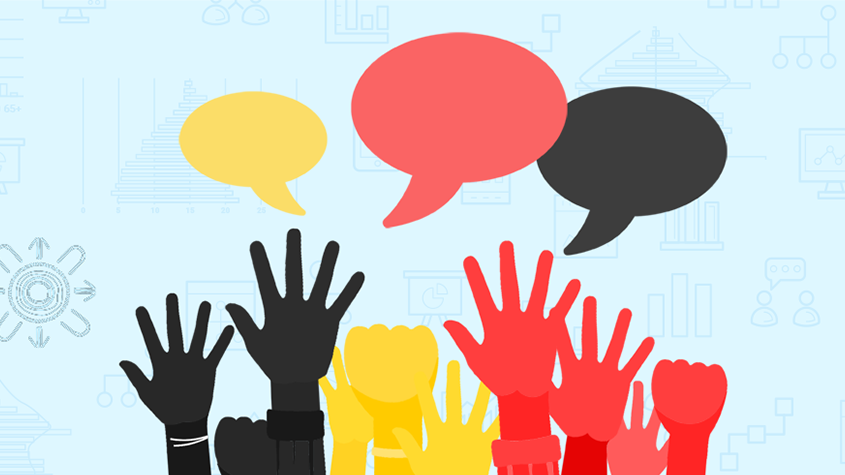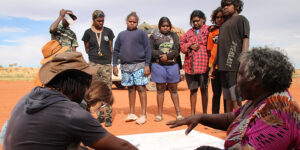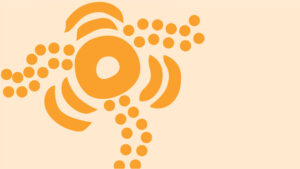
Data sovereignty, community control and better outcomes
How data sovereignty can empower First Australian communities to define success on their own terms, and in so doing, improve outcomes for people.

- There is a long history of data collection being undertaken in First Australian communities, where those communities have had little input to, and derived little benefit from, that research.
- Data sovereignty is a movement which seeks to retain and return data ownership rights to the communities where it is collected.
- In doing so, data sovereignty can improve outcomes for First Australian peoples, by capturing what matters to them, including about their culture and their strengths, and ultimately improve policy and programs.
This is the first in a series of articles in which we explore the role of data and evidence of what works in relation to delivering improved outcomes for and with First Australian1 communities. The second article, How can evaluation better recognise Indigenous self-determination? explores the implications of Indigenous peoples’ right to self-determination for evaluating policies and programs that affect Aboriginal and Torres Strait Islander peoples.
In this article we explore the role of First Australian peoples, particularly through community-controlled organisations and peak bodies, in defining measures of success, collecting data and influencing program and service improvement.
Data sovereignty
There is a long history of research being undertaken in the Aboriginal and Torres Strait Islander community in which the researcher or a third party is the beneficiary of the research. It is not uncommon for Aboriginal and Torres Strait Islander communities to never hear from the researchers again or not have any control or say in how the research is used over time. But the more substantive issue is that the research often does not address the priorities that are important to Aboriginal and Torres Strait Islander communities.
Aboriginal and Torres Strait Islander people are now pushing back on this approach, and organisations like the Australian Institute of Aboriginal and Torres Strait Islander Studies (AIATSIS) are at the forefront of developing culturally appropriate research ethics that place community at the heart of decision-making and influencing the ownership and use of data.2
Data sovereignty is the idea that data are subject to the laws and governance structures within the nation it is collected. For Aboriginal and Torres Strait Islander communities this means that data should be subject to the laws and governance structures of Aboriginal and Torres Strait Islander nations or as articulated by the University of Arizona ‘Indigenous data sovereignty is the right of a nation to govern the collection, ownership, and application of its own data.3
Earlier this year a Special Gathering of prominent First Australians came together to mark the 10thAnniversary of Closing the Gap to advise government on the future direction of that agenda. In a statement following that gathering they noted:
“The best progress over the last 10 years has been in areas where the Aboriginal and Torres Strait Islander community has led the design and implementation of programs from the beginning.”
Australian National University (ANU) professor Ray Lovett points out that the ability of Aboriginal and Torres Strait Islander people to inform and influence policy, program decisions, and outcomes is heavily reliant on their access to appropriate data.4
Data sovereignty will also play a key role in strengthening this evidence base.
While there is anecdotal evidence around the importance of self-determination and community control, the evidence base in Australia is still weak.
In November, ANU announced a landmark study, led by Lovett, that will seek to formally measure these anecdotal beliefs.5
Data sovereignty will also play a key role in strengthening this evidence base.
Understanding the evidence of what works or is effective in achieving outcomes within Aboriginal and Torres Strait Islander communities would empower community-controlled organisations to better understand their work, and the work of their peers, and allow them to prove what is widely agreed anecdotally – that they are delivering better outcomes for Aboriginal and Torres Strait Islander people than mainstream service providers.
Moving ownership from government to community
Currently the Federal Government is the owner of most outcomes data. This data has been built up over time and includes data that is obtained through grant acquittal requirements. First Australian people and organisations have been given little opportunity to contribute to decision making on what data should be collected and why. As a result, data collected has had a deficit focus, or what Professor Maggie Walter calls 5D Data: difference, disparity, disadvantage, dysfunction and deprivation.6
When government holds ownership of a community’s data it removes a community’s ability to define what success looks like for them – an imperative for self-determination.
Governments are not necessarily concerned with or understanding of issues that have far greater importance to Aboriginal and Torres Strait Islander people. If we take the current ‘Closing the Gap’ targets as an example they are silent on culture. For Aboriginal and Torres Strait Islander people, culture is always at the centre of thinking so outcomes should relate directly to culture.
Government ownership of data also makes it more difficult for the community to access the data that is collected, says Dr Nicholas Biddle, Associate Director, ANU Centre for Social Research and Methods.
… that’s very, very hard to access for someone outside of government or who doesn’t have institutional privilege…
“The largest longitudinal data set we have in Australia has data on between 25,000 and 30,000 Indigenous people, and that’s very, very hard to access for someone outside of government or who doesn’t have institutional privilege as I do at ANU,” Biddle says.
These barriers can have negative consequences, he adds. Take evaluations of school enrolment and attendance. The data exists, and has been constructed and evaluated by government, but never made available for interrogation by the communities it relates to.
Biddle says, it is conceivable that the resulting policies had a large, negative effect in those communities.
Enabling communities to access relevant data and provide input into policy development and program design would help to rebalance the power relationship and is more likely to result in better outcomes.
“However,” Biddle notes, “in stating the limitations, there is much more data than was ever available before. So access is improving.”
What would a community-controlled sector empowered by data sovereignty look like?
National Aboriginal and Torres Strait Islander Legal Service (NATSILS) Executive Officer Karly Warner says if Aboriginal community-controlled organisations (ACCOs) were given more control over what information is collected, how it’s collected and used, and the system that supports those functions, the unique strengths of individuals, families and communities could be leveraged to get better outcomes.
What may not be captured is that they have close connections to family and are receiving emotional and cultural support from community members.
“When a client comes to an Aboriginal and Torres Strait Islander Legal Service (ATSILS) for culturally safe assistance, we are required to record if that person is experiencing financial disadvantage,” explains Warner.
What may not be captured is that they have close connections to family and are receiving emotional and cultural support from community members.
Warner says that if Aboriginal and Torres Strait Islander communities had more ownership over what data is collected and what success looks like, a strong evidence base may have already been developed which shows what is known anecdotally – that access to family and culture is a key protective factor for reducing contact with the justice system.
… then ACCOs could determine what is working and what’s not and communicate that impact before governments make policy decisions for us and without us.
“We’ve got a real opportunity to empower Aboriginal and Torres Strait Islander communities to maximise the use of data for the benefit of our communities whilst also recognising the importance of ACCOs and their connectedness to community through, for example, language and family groups and who are best placed to understand the diversity of communities,” Warner says.
ACCOs already play an important role, Warner says, helping shift the narratives produced by data which communities do not ‘own’ but is rightfully theirs.
“If we had a greater role in defining, collecting, analysing and controlling our own data with true data sovereignty, then ACCOs could determine what is working and what’s not and communicate that impact before governments make policy decisions for us and without us.”
Linking data to better understand what drives change
Some may wonder why data sovereignty is more important in the First Australian context than for other cohorts in society. The answer is largely cultural and historical. Since 1967 when the Commonwealth Government assumed responsibility for Aboriginal and Torres Strait Islander policy, there has been no significant shift on all of the headline indicators of health and wellbeing. The challenge is to understand how much of this is tied to the lack of understanding of what works in communities and if the correct drivers of change are understood.
… there hasn’t been a good discussion at the Commonwealth level about how all the determinants related to Indigenous well-being connect.
Biddle says making data available from multiple organisations is particularly important in the Aboriginal and Torres Strait Islander context, where no one service provider has control over any single determinant that impacts the success of their programs.
“There’s often multiple organisations working in a single community, even on a single issue. So there might be multiple health providers, or multiple employment providers.
“There’s an additional challenge of attribution.
“It might be that one organisation is doing a great job, and one organisation is doing a poor job and having negative consequences. The data for that community might indicate that there is no effect.”
The Congress of Aboriginal and Torres Strait Islander Nurses and Midwives CEO, Janine Mohamed, who has also worked in policy at the National Aboriginal Community Controlled Health Organisation, says there hasn’t been a good discussion at the Commonwealth level about how all the determinants related to Indigenous well-being connect.
“In terms of data and intersectionality, I don’t think there has been much work done on that at all,” she says.
“What does it mean to have Aboriginal health services within a community? It means more than a building. It means role models for kids to enter health care. It means so much in terms of social determinants. The community having a physical presence within a town – so pride.”
First People’s Disability Network Australia (FDPN) Policy and Research Officer Scott Avery agrees. Earlier this year FDPN released Culture is Inclusion, a report which combined statistical data with personal testimony to tell the story of Aboriginal and Torres Strait Islander people with a disability that Avery says was hidden until now.
“People are fronting up to job interviews, or going to school, but they are not being included, because they are faced with racism or ableism,” he says.
“That’s what’s holding us back, not our aspiration to get a job. We need that acknowledged.
“The concept of disability, there’s a discourse surrounding it that is deficit based. We need to know that in order to navigate the system. But what’s really important to us is our connection to culture and community and being included.”
… to navigate support systems, Aboriginal people have to disable themselves, almost in contradiction of their culture.
Avery adds that Aboriginal culture generally doesn’t view disability through a deficit lens, which further complicates data collection.
“Aboriginal people don’t innately identify as having a disability,” he says, a point reinforced by the Culture is Inclusion findings.7
“I’m profoundly deaf, they might say I’m a bit dembin (mentally unwell). It’s not seen as a deficit. But to navigate support systems, Aboriginal people have to disable themselves, almost in contradiction of their culture.
“So not only do we get the stigma [of having a disability], we don’t get the support. Ticking the box that says ‘disability’ is the trigger for the support [but we are reluctant to tick it].”
Avery, who has a Masters in Health Information Management, has the skills required to work with the government to unlock insights from data sets, but that’s not the case for all organisations.
Warner agrees and says ACCOs need to be given the resources to build capacity, both in terms of infrastructure and expertise, in order to have greater control over the data they produce.
An Indigenous evidence intermediary: formalising community control and collaboration
In its submission to the Closing the Gap Refresh, NATSILS recommended the creation of an independent Aboriginal and Torres Strait Islander community-controlled evidence intermediary.
The concept of an Indigenous evidence intermediary, as one way of returning data sovereignty to Indigenous peoples, appeals to Warner in large part because she believes it would help break down a portfolio-based approach to policy.
“We need governments to understand the impact if we had greater control and greater resources to collect, analyse, evaluate and interpret the data, and were able to interact right across our communities and across sectors,” Warner says.
“We need the capacity to talk to SNAICC (national non-government peak body representing the interests of Aboriginal and Torres Strait Islander Children) about what their strengths-based data is telling them, versus what ours is telling us, for example.
We want a relationship between funders and those delivering services that is strong and respectful, with principles of co-design from the very beginning.
“There are challenges around how data is collected, counted, reported and analysed. We want to work with government to overcome these hurdles in a way that doesn’t create an additional reporting burden for ACCOs.
“Monitoring performance is important, but currently the balance is skewed too heavily towards compliance. Rarely do we see the reporting process when it comes to government-funded initiatives forming the basis for policy improvement or performance enhancement.”
“We want a relationship between funders and those delivering services that is strong and respectful, with principles of co-design from the very beginning.”
Collecting data that is useful
As the cases of NATSILS and FPDN indicate, individual organisations are becoming increasingly sophisticated at capturing information about their community. Information collected as part of delivering programs in communities paints a much more granular picture of individual communities than government owned data.
Because if I fill in a form and say I’ve got a child with a disability they might come and take them.
For example, ACCOs have more accurate data on the number of Aboriginal people living in their community than the Australian Bureau of Statistics.
FPDN understands Indigenous people are reluctant to report a disability not only because the deficit-based construction of disability from health goes against culture. But also for fear of discrimination.
“I came up with this concept called apprehended discrimination. I have a rational fear that I’m going to be discriminated against, so I’m not going to fill the form in,” Avery says.
“Because if I fill in a form and say I’ve got a child with a disability they might come and take them.”
The result is a large ‘evidence gap’.
Lovett highlights other reasons for the lack of accurate data held by the national data collection agencies.
“At the national statistics office level, there seems to be a difficulty converting concepts into questions that capture meaningful data about important constructs that give Aboriginal and Torres Strait Islander lives meaning and value, despite having Indigenous advisory structures,” he says.
“The result is a large ‘evidence gap’.
“Aboriginal and Torres Strait Islander people who have observed the inability of government (despite the advice) to progress in this area have become disengaged or distrustful. This is likely the result of previous experience in research in general, and concerns such as who controls the process of question (data) development, sampling, data collection, data analysis, data interpretation (context) and reporting of those data.
“Calls for ‘Indigenous data sovereignty’ stem from these historical legacies and point to a future where Indigenous people maintain, control, and protect their data and resulting intellectual property.”
And with control of data comes increased power for First Australian peoples to make decisions that will ultimately lead to better outcomes for their communities.
Authors: Jason Eades and Brendan Ferguson
The second article in this series, ‘How can evaluation better recognise Indigenous self-determination?’ explores the implications of Indigenous peoples’ right to self-determination for evaluating policies and programs that affect Aboriginal and Torres Strait Islander peoples.
[1] SVA uses the term First Australians to refer to Aboriginal and Torres Strait Islander peoples. In this article we use the various terms First Australians, Indigenous, and Aboriginal and Torres Strait Islander to reflect the preferred terminology of the interviewees.
[2] Guidelines for Ethical Research in Australian Indigenous Studies, Australian Institute of Aboriginal and Torres Strait Islander Studies (AIATSIS)
[3] The University of Arizona, Native Nations Institute on Indigenous Data Sovereignty and Governance
[4] Indigenous data sovereignty: towards an agenda, edited by Tahu Kukutai and John Taylor, ANU Press, 2016.
[5] Landmark study to examine health benefits of Indigenous connection to country, The Guardian, November 2018,
[6] The voice of Indigenous data: beyond the markers of disadvantage, croakey, April 2018
[7] Twelve factors that can influence the participation of Aboriginal people in disability services, Gilroy J, Donelly M, Colmar S, Parmenter T, Australian Indigenous Health Bulletin, 2016










